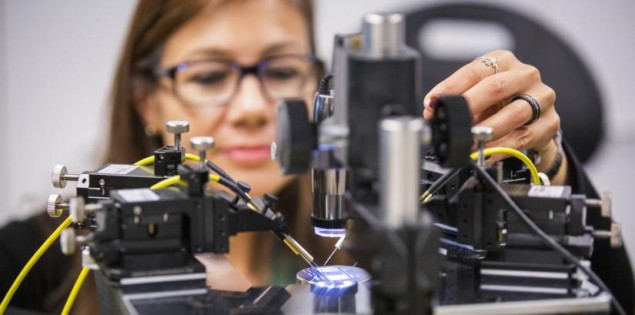
Brain–machine interfaces provide a bridge between the human brain and external software or hardware. Such systems detect the brain’s electrical signals and translate them into commands for electronic systems such as a computer or robotic arm. The neural signals can be collected non-invasively using electroencephalography (EEG) electrodes attached to the scalp.
Recently, researchers have developed EEG sensors made from graphene, which offers excellent conductivity and biocompatibility. Graphene-based biosensors, however, often have low durability, corroding upon contact with sweat, and exhibit high skin-contact impedance that hampers the detection of signals from the brain. A novel graphene-based biosensor developed at the University of Technology Sydney aims to overcome these limitations, detecting EEG signals with high sensitivity and reliability – even in highly saline environments.
The sensor, described in the Journal of Neural Engineering, is made from epitaxial graphene (EG) grown on a silicon carbide (SiC)-on-silicon substrate. This structure unites graphene’s favourable properties with the physical robustness and chemical inertness of SiC.
“We’ve been able to combine the best of graphene, which is very biocompatible, very conductive, with the best of silicon technology, which makes our biosensor very resilient and robust to use,” says senior author Francesca Iacopi in a press statement.
Performance testing
To create the new biosensor, Iacopi and colleagues used highly doped silicon substrates coated with a roughly 500 nm-thick film of cubic SiC; they then deposited layers of EG directly onto the SiC surface. They fabricated five of the EG-based sensors and tested each more than 10 times.
The researchers first characterized SiC and the EG-on-SiC films in a three-electrode cell set-up, using 0.1 M salt solution (to mimic sweat) as the electrolyte. They used electrochemical impedance spectroscopy (EIS) to quantify the transfer impedance between the electrodes and the electrolyte. The EIS curves indicated an improved transfer impedance for EG after 100 cycles, compared with both the initial EG cycle and the reference SiC films.
To evaluate the EG sensor for on-skin applications, the team measured the skin-contact impedance, which has a crucial effect on the performance of EEG sensors. The sensor was mounted on a pin button connector and placed on a volunteer’s forearm in a three-electrode configuration. On-skin EIS measurements showed that the contact impedance between the graphene sensors and the skin reduced drastically after repeated testing.
While the EG sensors did not show particularly low skin-contact impedance in the first test, by the third sequential test this had reduced drastically, stabilizing at 130±10 kΩ at 50 Hz. The researchers note that this value is far lower than that of two commercial dry EEG sensors tested in the same configuration: a spring-loaded pin sensor and a conducting foam sensor, which exhibited skin-contact impedances of around 830 and 665 kΩ, respectively.
“With our sensor, the contact resistance improves when the sensor sits on the skin,” Iacopi explains. “Over time, we were able to achieve a reduction of more than 75% of the initial contact resistance. This means the electric signals being sent by the brain can be reliably collected and then significantly amplified, and that the sensors can also be used reliably in harsh conditions, thereby enhancing their potential for use in brain–machine interfaces.”
The researchers attribute this improvement after prolonged skin contact to the formation of oxygen functional groups on the graphene grain boundaries, which lead to the formation of a thin layer of physisorbed water covering the grains. They refer to this newly observed phenomenon as “surface conditioning”, noting that the effect is consistent and repeatable, countering the natural hydrophobicity of graphene to obtain a better contact with the skin.
Tests on EG sensors in contact with a saline-soaked cloth showed similar behaviour to those on skin, but stabilizing at far lower contact impedance values (6.5±0.5 kΩ at 50 Hz). The team suggests that the presence of saline at the interface between the graphene electrodes and their contacts (skin or cloth) is beneficial for lowering the overall contact impedance and primes the surface conditioning effect.
EEG sensors typically detect signals from the brain using electrodes placed over the head. To examine the suitability of EG sensors for EEG signal collection, the researchers placed an EG sensor on a volunteer’s forehead. The skin-contact impedance on the forehead was 90±5 kΩ at 50 Hz, lower than that measured on the forearm.
Using an elastic headband to hold the sensors tightly to the forehead reduced the skin-contact impedance further, to 44±4 kΩ at 50 Hz. The team attributes this to the tighter sensor–skin contact, the harder contact surface offered by the forehead and the sweat generated underneath the headband.

BrainGate: untangling the brain–computer interface
Finally, the researchers mounted the EG-based EEG sensors on a brain–interface helmet system containing eight channels connected to foam sensors, replacing two channels at the forehead with the EG sensors. The EG sensors showed a similar blinking signal to the commercial foam sensors, indicating the potential of their use in future brain-controlled applications.
Iacopi and colleagues conclude that EG fabricated on SiC-on-silicon substrates can create robust and reliable electrodes with low contact impedance for brain–machine interfaces. They note that the surface conditioning effect could be exploited to develop a pre-conditioning procedure that further optimizes the sensor performance.



